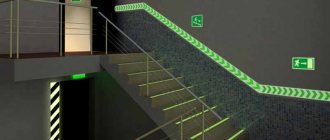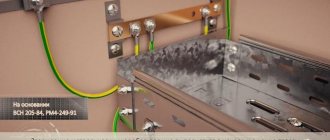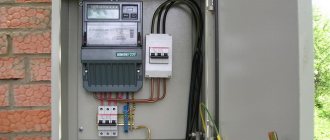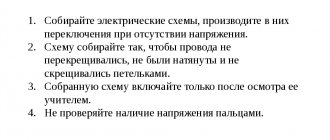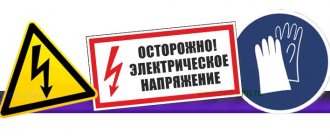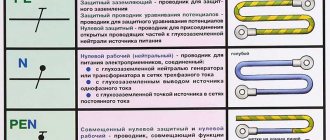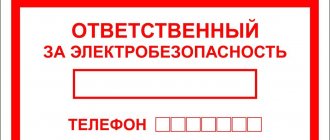Fire safety requirements for electrical installations are the most important component of a facility’s fire safety. They are confirmed by such legislative acts as PUE - Rules for the Construction of Electrical Installations, PTE - Rules for the Technical Operation of Consumer Electrical Installations, PTB - Safety Rules for the Operation of Electrical Installations.
At industrial enterprises, much attention is paid to the correct selection of electrical installations in accordance with the explosion and fire hazard classes of premises, which are indicated in the PUE. On the doors of the latter there must be a sign on which this class is written.
All electrical installations are divided into two categories: up to 1000 volts and above. Therefore, fire safety in electrical installations up to and above 1000V is considered separately.
Causes of fires in factories
Since fires often occur in enterprises, statistics on the causes of fires have long been compiled.
- 33% relates to violations related to the operation of technological equipment. For example, sparkling parts, poor insulation of electrical wiring, etc.
- 16% is untimely inspection and repair of electrical equipment.
- 13% - poor training of company employees in terms of fire safety at the enterprise, which also includes a poorly organized and equipped workplace.
- 10% - improper storage and use of flammable materials.
From practice we can conclude that not all employees treat their responsibilities as expected. This means that the management of the enterprise must strengthen control over everyone. And here well-developed fire safety rules at work will play an important role.
"Origins"
The village of Rodionov (Nesvetaysky), which is mentioned in the Russian chronicle in the journal of the military chancellery No. 5 of October 30, 1819 (military archive), is one of the many colonial territories of the nobility of the Russian Empire of the late 18th and early 19th centuries, who established their settlements on the banks of the Bolshoy Nesvetay , Tuzlova and their tributaries. Here the Scythians pulled the strings of their bows. In these parts, the warriors of Grand Duke Vladimir fought with the Khazars and Pechenegs, defending their native land, and the brave knight Ruslan crossed his sword with the Khazar prince Ratmir. Here, on May 10, 1185, a battle between the troops of Igor, Oleg’s grandson, and the Polovtsians took place. According to folk legends, Prince Burbuk set up his nomadic camps in the upper reaches of Nesvetaya.
Returning to the beginning of the 19th century, it should be considered that, unlike the village of Rodionova, which dates back to 1802, the older settlements within the boundaries of the region are the settlements of Isaevka (Barilo-Krepinskaya) and Krepkaya (Bolshekrepinskaya).
According to the 1801 census, in the first there were 307 households with a population of more than 2.5 thousand people, and in the second - 497 households with a population of almost three thousand.
“Roots of a tree: whose name does the settlement bear?”
The official biography of Rodionovo-Nesvetaiskaya begins with its foundation at the beginning of the 19th century on the river. Big Unlight. According to the definition of the military chancellery, Rodionov (Nesvetaysky) village near the river. Big Unlight. The colonizer of the Nesvetaysky village was Lieutenant Colonel Mark Rodionov.
Mark Ivanovich Rodionov (1770-1826) - Major General, hero of the Patriotic War of 1812 and the Foreign Campaigns of 1813 and 1814.
Born in 1770 in Cherkassk, the son of Major General of the Don Cossack Army Ivan Rodionov. He was enrolled in military service on January 1, 1782 in the Don military administration, reported for duty on April 2, 1786 and was enlisted as a centurion in his father’s regiment.
On March 18, 1798 he received the rank of colonel. In 1801-1802, Rodionov was on the Don, where he held the position of present rank in the police department. At this time, he became the founder of the Rodionovo-Nesvetaisk settlement in the Rostov region. The name comes from the surname and the present river Sukhoi Nesvetai. Since 1803, he was with the regiment on the Austrian and Polish borders, where he performed cordon service.
He took part in numerous battles and campaigns, for which he was awarded the Order of St. George, 4th degree (No. 2593 to the list of cavaliers of Grigorovich - Stepanov) “For distinction in the battle with the French at Tempelberg”, Order of St. George, 3rd degree (No. 310 to the cavalry lists) “In reward for the excellent courage and courage shown in the battles against the French troops on November 15 and 16, 1812 at Borisov and Studyanka.” Rodionov also had the Order of St. Alexander Nevsky, St. Anne 1st degree with the imperial crown. Vladimir 2nd degree.
He died in the fall of 1826 and was removed from the service records on November 9.
Page 3.
“And the years fly by and know no barriers”
What has changed since those times, from the governor Mark Rodionov to the present day? A lot of water has flowed from Nesvetai, feeding the Don and the Sea of Azov. The years of revolutionary events, the Civil War and the Great Patriotic War swept by like a hurricane.
The long-suffering settlement and its population have seen everything in their lifetime: ups and downs, the joy of victories and the bitterness of losses.
The participants and witnesses of the Great Patriotic War - the bloodiest and most destructive - are still fresh in the people's memory and alive. Hundreds of Rodionovo-Nesvetais in June 1941, at the call of the Motherland, exchanged peasant and working tools for military weapons and became infantrymen, tank crews, artillerymen, scouts and sailors, and the remaining women, old people and children worked from dawn to dusk on the construction of defensive fortifications as best they could , helped the front.
Hundreds of Rodionovo-Nesvetais distinguished themselves in battles for their homeland, showing courage, heroism and bravery. The indigenous settlement residents Butsulins and Butenkos, Uzhakins and Fedorenkos, Likhobabins and Efimovs, Vashchenkos and Chebotarevs, Kharchenkos and Stepanenkos, Koshelevs and Solovyovs, Nechitailovs and Lyskins, Lepetukhins and Barannikovs, Leonovs and Garazhins, Burlukovs and Ivanovs, Ryab desperately fought with the hated enemy. Tsev and Serdyukov , Golenko and Azarov, Matvienko and Chukhlebov, Petrov and Vasiliev, Ignatenkov and Popov, Rushchenko and Dudnichenko, Grigoriev and Chebanenko, Goncharov and Lobintsev, Kaplunov and Boyko, Dronov and Karpenko, Shevchenko and Smirnov, Savchenko and Kirsanov, Shlensky and Degtyarev, Polyakov and Gromakovs, Poddubnys and Tsirkovs, Ryndins and Pulichevs, Kolesnikovs and Kuleshovs, Likhachevskys and Korsunovs, Marchenkos and Samaras, Zorichevs and Simonovs, Dovydovs and others.
Two of our fellow countrymen were awarded the highest state awards: Vasily Ivanovich Burenko - the title and Golden Star of Hero of the Soviet Union, and Nikolai Anfimovich Vashchenko - three Orders of Glory.
Page 4.
"Rodionovo-Nesvetaiskoe rural settlement."
The Rodionovo-Nesvetaysky rural settlement includes the following settlements: sl. Rodionovo-Nesvetaiskaya, h. Avilov, H. Big Debtor, x. Merry, x. Novoegorovka, h. Pavlenkov, H. Kalinovka.
The total area of the settlement is 205 square meters. km. As of January 1, 2017, 8,588 people live on the territory of the settlement.
Quite a few people have replaced the chairman of the Rodionovo-Nesvetaysky village council:
1. Masyutin Alexey Fedorovich from 12/26/1950 to 11/04/1954
2. Dmitry Nikolaevich Chasovskoy from November 4, 1954 to December 16, 1969
3. Leonov Nikolay Alekseevich from 12/16/1969 to 02/05/1970
4. Venzik Sergey Semenovich from 02/05/1970 to 01/12/1971
5. Butsulin Ivan Andreevich from 01/12/1971 to 08/20/1973
6. Klavdiya Aleksandrovna Strelchenko from 1973 to 1975
7. Logvinov Ivan Ivanovich from 06/22/1975 to 03/11/1985
8. Nadezhda Vasilievna Molodykh from 03/22/1985 to 01/23/1992
Since January 24, 1992, the executive committee of the Rodionovo-Nesvetaisk village council became the Rodionovo-Nesvetaisk local Administration, which was also headed by Nadezhda Vasilyevna as the Head of the Young.
From 07/08/1996 to 11/10/2003, Natalya Ivanovna Pankevich was appointed to the position of Head of the Rodionovo-Nesvetaysk Rural Administration
From November 13, 2003, Viktor Pavlovich Puts became the Head of the Rodionovo-Nesvetaisk Rural Administration, and from January 1, 2006 to October 25, 2012, he served as the Head of the Rodionovo-Nesvetaisk rural settlement.
On October 26, 2012, Gennady Aleksandrovich Golubov was elected Head of the Rodionovo-Nesvetaysky rural settlement
Since October 27, 2017, the Administration of the Rodionovo-Nesvetaysky rural settlement has been headed by the head of Sergey Sergeevich Gruzdev, and the Rodionovo-Nesvetaysky rural settlement itself has been headed by the Chairman of the Assembly of Deputies - the head of the Rodionovo-Nesvetaysky rural settlement, Alexander Anatolyevich Kondratyuk.
Personnel requirements
At energy facilities, as at any other important facility, there should be no unauthorized persons present. And all data about visits is recorded in the shift log
Additional fire safety requirements for electrical installations have been developed for personnel and employees.
Personnel and employees are not allowed to use damaged sockets and switches. All malfunctions must be reported to superiors in a timely manner, and problems must be corrected in a timely manner. All home-made devices, and especially devices with open heating elements, should never be used at work.
Factory-made devices can only be used in good condition and with good thermal insulation in the form of stands. Do not use the oven without thermoregulation.
Indoors and within a radius of 50 m outdoors, you must not use flammable materials or burn garbage and waste.
Legal regulation
The state pays considerable attention to fire safety issues during the operation of electrical installations. In order to prevent emergency situations, special technical regulations have been adopted, which set out a number of requirements for electrical devices and their operation in order to reduce the likelihood of fires:
- Electrical appliances located in premises must comply with the fire hazard class of such premises;
- If the building is constantly occupied by people, it must be equipped with an automatic fire extinguishing system with a backup power source, since the main electrical network may fail during a fire;
- Doors, elements of the fire extinguishing system, elevators, stairs and other objects through which people can evacuate must be in good working order and be able to function during a fire for a time that is sufficient to complete the evacuation process;
- Transformer cables and wires to provide a fire extinguishing system must be laid in fire-resistant channels and have insulation that is resistant to combustion and has a low level of smoke generation;
- The power supply system must be equipped with a special panel containing devices for its emergency shutdown in the event of a sharp increase in voltage, temperature, and so on. The shield itself must be fire-resistant and made of such material that in the event of a fire the flame cannot spread to nearby objects.
Technical regulations for fire safety
Emergency situations and recommendations for behavior
Safety precautions when handling electric current
If you fully comply with fire safety requirements for electrical installations, the likelihood of a short circuit followed by a fire will be minimized. But at the same time, it is very important to constantly monitor the condition of electrical devices, carry out their maintenance in a timely manner, and as soon as any sign of a malfunction or unusual situation is noticeable, you should immediately stop using the device and call specialists. External signs of a fire hazard in electrical installations may include:
- When you plug in the device, sparks appear and the plug or socket constantly heats up. As a rule, this occurs due to weak contacts. In such a situation, it is necessary to change either the plug or the socket. Do not place any foreign object into the outlet to create contact or entangle any material around the plug;
- When the device is turned on, the illumination in the room decreases. The reasons for this situation may be different, but in most cases, this is a sign of network overload. There are several solutions to this problem. The first is to refuse to use any electrical installations. If this is not possible, then you should turn them on alternately. For example, in everyday life it is not recommended to use a washing machine and a kettle at the same time. The second solution is to carefully check the electrical circuit for twists and weak contacts. In conditions of network overload, the presence of a weak contact is almost guaranteed to lead to a fire. If such problem areas are found, they should be eliminated immediately. The most expensive, but at the same time the most correct way is to replace the wiring. In this case, you should lay a wire with a large cross-section and an appropriate level of fire protection.
Non-standard situations
So, the requirements for the safe operation of electrical installations can significantly reduce the risk of fire, which means preserving property and avoiding loss of life. There are no difficulties in complying with them. It is enough just to be careful and promptly pay attention to various non-standard situations when operating electrical appliances.
Absolutely forbidden
The following measures and actions, from a fire safety point of view, are unacceptable when operating electrical equipment in an enterprise, office or residential area:
- connect to the network electrical devices whose heating is higher than the ambient temperature by 40 degrees Celsius or more;
- use electrical equipment with damaged wire insulation and electric heating devices without fireproof stands;
- leaving electrical appliances on for a long time;
- connect homemade heating electrical appliances for heating;
- use wood for insulation;
- bringing explosive materials into the enterprise for employees;
- store flammable liquids near electrical devices and wiring.
Fire prevention
Fires at an enterprise can be prevented by observing fire safety measures when working with live equipment and performing preventive inspections of installations at least once a week:
- all personnel must be familiar with safety instructions when working with electrical equipment, and also know the procedure to follow in the event of a fire;
- The electrician should systematically carry out scheduled preventive inspections of live installations;
- wires and connections must be insulated, automatic regulators and fuses are installed throughout the building;
- store protective clothing and fire extinguishers in a separate room;
- at the end of the working day, on holidays and weekends, the entire electrical network in the institution must be turned off. The exception is automatic lighting.
Extinguishing electrical fires is a complex, painstaking job for the fire department. In order to avoid troubles with the Ministry of Emergency Situations, you need to carry out preventive measures in a timely manner and responsibly adhere to operating rules when working with electrical wiring and energized equipment.
Detailed information is visible in the video:
How to ensure fire safety in electrical installations
According to statistics provided by the Main Directorate of the Ministry of Emergency Situations of Russia for Moscow, 31.5% of all fires in the capital - and this is more than 1,600 cases per year - are caused by violations of the rules for the design and operation of electrical equipment. In industrial enterprises, such fires, causing large material damage, have very tangible economic consequences for the entire production.
Rice. 1. Block transformer fire extinguishing system
Fire safety requirements for electrical installations of buildings and structures
Ensuring fire safety in electrical installations should be carried out in two main areas:
· fire prevention;
· effective extinguishing of a fire when it occurs.
According to clause 1.7.18 of the Rules for the technical operation of consumer electrical installations, approved by Order No. 6 of the Ministry of Energy of Russia dated January 13, 2003, the fire safety of any electrical installations, as well as the premises, structures and buildings in which they are located, must comply with currently relevant fire safety requirements . First of all, such requirements are contained in Article 82 of the Federal Law of July 22, 2008 No. 123-FZ “Technical Regulations on Fire Safety Requirements” (hereinafter referred to as the Technical Regulations), but they can also be found in the following documents:
· “Rules for the construction of electrical installations (PUE).” They act as separate sections and chapters of the last two editions: the 6th - introduced on November 1, 2003, and the 7th - introduced in parts: January 1 and September 1, 2003 and December 20, 2022 (see Table 1 below).
· Set of rules “SP 5.13130.2009. Fire protection systems. Fire alarm and fire extinguishing installations are automatic. Design norms and rules."
· Set of rules “SP 9.13130.2009. Fire equipment. Fire extinguishers. Requirements for operation."
· Set of rules “SP 112.13330.2011. Fire safety of buildings and structures. Updated edition of SNiP 21-01-97*.”
· Set of rules “SP 56.13330.2011. Industrial buildings. Updated version of SNiP 31-03-2001.”
· Code of rules “SP 118.13330.2012*. Public buildings and structures. Updated version of SNiP 06/31/2009.”
· Set of rules “SP 44.13330.2011. Administrative and domestic buildings. Updated version of SNiP 2.09.04-87"
· Construction norms and rules “SNiP 31-04-2001. Warehouse buildings."
· Order of the Ministry of Labor of Russia dated July 24, 2013 No. 328n “On approval of the Rules for labor protection during the operation of electrical installations.”
· Order of the Ministry of Energy of Russia dated September 13, 2022 No. 757 “On approval of the Rules for switching in electrical installations.”
· Interstate standard “GOST 31565-2012. Cable products. Fire safety requirements."
· National standard “GOST R 53316-2009. Cable lines. Maintaining operability in fire conditions. Test method".
· National standard “GOST R 50571.5.52-2011/IEC 60364-5-52:2009. Low voltage electrical installations. Part 5-52. Selection and installation of electrical equipment. Electrical wiring."
· Letter of the Ministry of Emergency Situations of Russia dated September 20, 2010 No. 12-4-02-5294f “On the use of cable products.”
· Letter of the Ministry of Emergency Situations of Russia dated March 20, 2013 No. 19-2-4-1165 “On consideration of the appeal.”
Table 1. Contents of the PUE, acting as separate sections and chapters of the sixth and seventh editions
Fire prevention in electrical installations
Most fires in electrical installations occur, as already mentioned, due to their improper design, installation and operation. According to statistics, the main causes of fires in electrical installations are:
· short circuit;
· overload of windings, wires and cables;
· overheating of flammable substances or materials left near electrical installations;
· sparking and electric arc;
· heating of building structures when voltage is transferred to them.
That is why the most important element of ensuring fire safety is training all employees in fire safety measures and certain rules of behavior in the event of a fire, but in particular this applies to specialized personnel.
According to the order of the Ministry of Labor of Russia dated July 24, 2013 No. 328n “On approval of the Rules for labor protection during the operation of electrical installations,” electrical engineering personnel, depending on their membership in a particular electrical safety group, must know the Rules within the scope of their position:
· technical operation of electrical equipment;
· use and testing of protective equipment;
· electrical installations and fire safety devices.
The results of testing the knowledge of employees are documented in the Certificate and Protocol on testing knowledge of the rules of work in electrical installations, the forms of which are approved by Order No. 328n (Appendices No. 2 and No. 4, respectively). Thus, the sixth page of the Certificate and the “Results of Knowledge Test” section of the Protocol contain information about knowledge of regulatory and technical documentation on fire safety.
Rice. 2. Installation of an automatic gas fire extinguishing installation (AUGPT) in a container
Work in electrical installations using fire safety measures may only be carried out by trained personnel:
1) by written one-time order (valid for one working day/shift). For example, before carrying out work on cable lines in tunnels, such permission must be obtained simultaneously from the management of the organization, the local government and the owner of the communications. At the same time, before hot work, the fire-fighting automatics in them must be switched from automatic to remote control, and a poster “Do not turn on!” must be posted on the control key. People are working." When burning cables, it is prescribed to use shields made of fire-resistant material, gas cylinders with a capacity of no more than 5 liters, lamps with a voltage of no more than 12 V, forced ventilation to displace gases, and people can only be in areas between two open hatches (doors) with warning signs and fences.
2) with the issuance of a work permit (for a period of up to 15 calendar days from the date of commencement of work with the possibility of a one-time extension). When filling out the front side of the permit for work in electrical installations, in the “Separate instructions” line, additional measures are given to ensure fire safety, for example, checking the air in the room for the absence of hydrogen and/or installing fences.
Even at the design stage of electrical installations, it is necessary to follow the established rules. Letters from the Ministry of Emergency Situations of Russia No. 12-4-02-5294f and No. 19-2-4-1165 emphasize that ensuring the operability of cable lines can be confirmed by calculations, which must show that the time for evacuation of people to a safe zone will be less than the time of failure of cable products as a result of exposure to fire factors (heat, flame) that may occur along the cable route. The selection of specific brands of cable products for installation is carried out by the design organization or the organization performing the installation work, based on available certificates of product compliance with the requirements of the Technical Regulations on fire safety requirements.
To reduce the likelihood of a fire, electrical installations must be installed and operated in strict accordance with the design rules and technical operation rules. All electric motors, wiring, control systems, protective equipment must have protection devices against overload and short circuit currents. Electrical installations must be de-energized in all rooms that are locked and not supervised by personnel after the end of the working day. The exception is special electrical installations designed to operate round knocks.
When operating electrical installations, it is unacceptable to use them in conditions that do not comply with the instructions. The use of faulty electrical installations and the use of homemade repair methods, for example, homemade fuses to protect against short circuits, are also prohibited.
Compliance with safety regulations greatly reduces the risk of fire.
Rice. 3. Automatic aerosol fire extinguishing installation (AUAF) to protect electrical equipment
Automatic fire extinguishing of electrical installations and electrical equipment
When extinguishing a fire in energized electrical installations, the likelihood of electric shock to personnel is especially high, therefore, for a number of premises, the mandatory installation of automatic fire extinguishing systems and installations (AFES) is provided. Such facilities include rooms with electrical cabinets and electrical panels, server rooms, warehouses, premises of power plants, control centers, etc. In addition, automatic fire extinguishing systems are required for enterprises where a power outage can lead to disruption of the production cycle or significant material and information losses. damage.
The use of various types of automatic fire extinguishing equipment for extinguishing live electrical equipment is regulated by SP 5.13130.2009. Thus, according to this set of rules, automatic installations of powder, gas (see Fig. 2) and aerosol (see Fig. 3) types are allowed to extinguish fires in electrical installations. It is also possible to use fire extinguishing installations with finely sprayed water, but only for those cases where the voltage of the electrical installation is not higher than that specified in the technical documentation for this type of fire extinguishing system.
Clause 1.7.20 of the Rules for the Technical Operation of Consumer Electrical Installations states that electrical installations must also be equipped with primary fire extinguishing equipment. In most cases, gas (carbon dioxide) and powder fire extinguishers are used to fight fires in electrical installations.
Rice. 4. Fire extinguishing in the cell of the KTP-10 transformer (0.4 kV) according to approval
Electrical installations under voltage up to 0.4 kW are allowed to be extinguished using available primary fire extinguishing agents and without turning off the power, since in some cases a complete removal of voltage can lead to disruptions in the production technology of the enterprise (see Fig. 4).
Article 4.1.19 of the set of rules SP 9.13130.2009 prohibits the use of water fire extinguishers for fire extinguishing in electrical installations, but to eliminate fires in installations under voltage up to 1000V, it is permitted to use water or water-emulsion fire extinguishers with fine spray jets and passed electrical safety tests in accordance with GOST requirements. You can extinguish a fire with such a fire extinguisher only from a distance of at least 5 meters.
So, effectively combating possible fires at facilities with electrical installations should be ensured by well-designed and installed automatic fire extinguishing systems (AFS). Each individual case requires an individual solution, taking into account the characteristics of the protected objects and the requirements of regulatory - technical, departmental and industry - documents. In addition, it is not enough to simply install a fire extinguishing system; it must be effectively operated and professionally maintained.
The Integrated Security Alliance helps to successfully solve all these problems.
. For twenty years now, we have been working in the fire safety services market, advising clients on all fire safety issues, conducting qualified inspections of facilities, designing and installing fire safety systems of any complexity, monitoring the continued serviceability of fire safety equipment, carrying out warranty and post-warranty maintenance and repairs under a contract — including equipment previously installed by third parties.
Rules for safe operation
During the operation of electrical equipment, various emergency situations may arise, for example:
- Instruments and devices suddenly begin to spark;
- Employees working on the equipment report elevated temperatures. Symptoms of a malfunction and short circuit are also overheating of the wires, which occurs due to excessive load in the network or improper connection of devices;
- Weak contact at the point where the device is connected to the electrical circuit (for example, a loose socket or broken plug), which also leads to overheating of the wires and subsequent fire;
- When the device is disconnected from the network, an arc occurs, which indicates a malfunction of either the equipment or wiring. In addition, the electric arc itself can lead to injury, since it has a fairly high voltage level;
- If there is a transformer in the device, the temperature of its winding should be monitored, since its sharp increase indicates the presence of overload and operational problems.
Conditions for the safe operation of electrical installations
If such a situation arises, it is necessary to act in accordance with the fire safety instructions approved by the enterprise. At home, it is recommended to follow basic fire safety rules: do not plug in a faulty device and contact a specialist for repairs.
Important! The most important fire safety rule when operating electrical installations is the requirement to disconnect them from the network after use. It is not allowed to operate electrical equipment in the absence of a person, as this may lead to a fire.
Only those devices that are necessary to maintain life can be permanently connected to the network.
Fire safety rules (FPR), both at the household level and at the enterprise, prohibit the following actions:
- Operation of faulty electrical equipment;
- Violation of the requirements of the manufacturer of electrical devices regarding the organization of safe work on them and maintenance rules;
- Cover lamps and lamps with any material, especially flammable (paper, fabric, etc.), since light sources also emit heat during operation, and an increase in the temperature of paper or fabric can lead to their fire. In addition, it is not recommended to use lamps without a diffuser in everyday life or in production;
- Operate the equipment without special stands made of fireproof material;
- Use home-made devices for work that have not passed the appropriate certification;
- Install electrical appliances and devices in separate niches that are poorly ventilated and made of flammable material;
- Connect equipment to a temporary network laid without complying with safety requirements.
Safety rules
Please note! Heating devices have the greatest risk of fire. Firstly, they are often operated without supervision, which automatically increases the likelihood of a fire.
Secondly, their surface has a high temperature, which, upon contact with a flammable substance, can cause a fire.
Measures to prevent fires in electrical installations
The process of ensuring fire safety in electrical installations is divided into three categories:
- design in accordance with legislative acts;
- installation of electrical installations and their adjustment in accordance with SNiPs and GOSTs;
- competent operation.
The first category is considered the most important because all elements, parts and materials are included in the design process. They must comply with GOST requirements and be certified. For example, cables are selected with the correct cross-section, taking into account the thickness and quality of insulation, current and voltage.
Installation of electrical installations in accordance with project requirements
The second stage requires full compliance with the project requirements. After completion of installation, electrical installations must undergo acceptance by a commission that will check them for compliance with the required standards.
As for operation, fire safety rules in electrical installations are also included here. The main thing is that the installations are serviced by specialists. They must carry out inspections, repairs, tests, modernization, etc. Let us add that the requirements for employees and their training are specified in the PTE, or more precisely, in paragraphs 1.4 and 1.7.
It is very important to carry out preventative testing. For example, measuring insulation resistance in electrical installations with special instruments. There are strict testing requirements:
- in particularly hazardous installations - once a year;
- in the rest - once every three years.
For some types of installations, test periods are not mandatory. Therefore, the recommendations and requirements of the manufacturer are taken as a basis.
Fire safety measures when operating electrical equipment include the following prohibitions. That is, it is prohibited:
- operate electrical conductors and electrical networks with defective insulation;
- use defective electrical installation elements;
- store flammable materials near electrical installations;
- allow untrained personnel to service them.
Cables with defective insulation must not be used
How to extinguish electrical installations
First of all, it is necessary to answer the question of what fire extinguishing means are not allowed to extinguish electrical installations at energized objects. It should be noted right away that if the electrical installation is de-energized, then it makes no difference how to extinguish it.
But if it is under voltage, then you cannot use powder products if the voltage exceeds 1000 V. The same applies to carbon dioxide. But air-foam ones are generally prohibited from being used. But they are used in cases where the housing of the electrical installation is destroyed, the oil has leaked out and created new fires. This is the most effective option. The only thing you need to do is turn off the power to the equipment.
Fire safety rules for the operation of electrical installations
PB requirements for electrical installations.
Fire safety of electrical installations must be observed by enterprise personnel in order to prevent electrical equipment from catching fire.
On a note. A sample document “Fire safety of electrical installations” can be downloaded from our website.
Contact status
During a preventive inspection of electrical equipment, attention should be paid to contact problems. Problems can be found in:
Problems can be found in:
- switches;
- plug connections;
- bolted connections.
When the connections become loose, the wires and bolts become hot and can cause a fire.
If it is discovered that the wires and contacts are excessively heated, measures are taken to unload the equipment (cleaning contacts, tightening screw connections).
Cleaning from dust
Cleaning of flammable dust from electric motors, wiring, and lamps should be carried out at least 2 times a month.
If dust accumulates on electrical equipment too quickly, it should be removed once a week.
To prevent excessive dust accumulation on electrical devices and wiring, ventilation should be monitored.
Phase load
Lack of uniform load across the phases of electrical receivers can lead to a fire. If the enterprise operates a single-phase electrical receiver, then phase current passes through the working neutral wire. In this regard, the cross-section of the phase wires must be calculated so that it is equal to the cross-section of the neutral wire in electric heating lighting installations.
Belt tension
The likelihood of fire in electrical installations at an enterprise is due to heating when belt drives slip. Timely inspection of equipment can reveal violations in the tension of V-belts and flat belts in the engine, as well as in transport equipment.
Short circuit protection
Electrical installations should be considered fire hazardous if they are not protected from short circuit current.
The means of protection are:
- circuit breakers;
- circuit breakers;
- overvoltage devices, etc.
Temporary electrical installations
The use of temporary electrical networks is prohibited, but the exception is illumination equipment and electrical wiring that operates at construction or installation sites. The fire safety regime requires full compliance with the instructions and recommendations of the PUE for working with such equipment.
Other requirements
Fire safety rules for the operation of electrical installations, dictated by VNIIPO, establish the following:
- All electrical panel fuses must have spare fuses in case the first ones fail.
- Wires of powerful electrical appliances can be connected and branched using welding, soldering and crimping. Twisting is prohibited!
- The transfer of electrical receivers is carried out using hose cables.
- It is prohibited to store flammable materials (linen, paper, cotton) in warehouses where electrical appliances are located.
- Lighting devices must be kept away from flammable materials, and wires must be insulated.
- Persons who are responsible for the condition of electrical equipment (electricians, electricians) are required to measure the insulation resistance of electrical devices once a week. At network voltages up to 1000 V, the resistance of the insulation section should not exceed 0.5 MOhm.
Requirements for installations up to 1000 volts
At any industrial enterprise there is a specialist who is responsible for fire safety. He is appointed by order of the head of the enterprise. This is usually an engineer who is trained in fire safety knowledge. He constantly undergoes advanced training in special training centers.
What are the fire safety requirements for the operation of electrical installations up to 1000V. This primarily concerns fencing, insulating and additional devices.
Walling
They are installed in hazardous areas where work is carried out on electrical installations with voltages up to 1000 volts. That is, repair, prevention, maintenance or monitoring of technical condition.
Enclosing structures include:
- shields;
- portable fencing;
- other devices of this type, which are installed only in the process of carrying out the above-mentioned work.
The main purpose of fencing according to the instructions is to prevent unauthorized entry by personnel of a production facility who do not have legal access. And an additional purpose is to indicate the place of danger.
Protective fencing structures - shields
Isolating devices
These products have a protective function against short circuits, fire and other unpleasant factors. These devices are made from special rubber. These include gloves, shoes, mats, barbells and other products.
The main purpose of using insulating devices is to prevent electric current from leaving the electrical installation. Accordingly, prevent the possibility of fire. Therefore, in the fire safety rules for the operation of electrical equipment, these means are designated as an element of a set of fire safety measures.
Dielectric gloves
Additional funds
Contact with electrical installations may result in thermal shock from electrical current. Therefore, workers who carry out repairs, maintenance and monitoring are provided with additional devices that have an enclosing (protective) function.
These include belts, gas masks, and special ropes that help minimize the negative impact of electrical installations.
